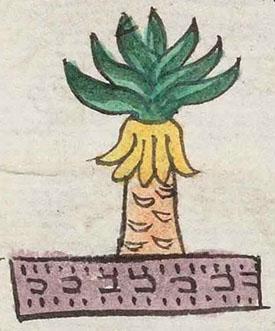Iczochinanco (Mdz42r)
This compound glyph for the place name Iczochinanco (perhaps "At the Yucca Palm Agricultural Field") consists of two principal elements, the iczotl) (yucca palm) and the chinamitl, an agricultural parcel. The yucca is standing upright, with a light orange trunk, and two-toned green foliage. In between these elements is a skirt-like fringe in a yellow color that seems to represent spent branches (once green, they turn yellow or tan in color as they dry). The trunk of the yucca tree also has a texture somewhat representative of the yucca palm in nature. The parcel is a purplish gray with dots and u's texturing it. The -co (locative suffix) is not visual, but perhaps the landscape provides a semantic locative.
Stephanie Wood
The iczotl plant has been translated as both yucca and date palm in the online Nahuatl Dictionary, and the Gran Diccionario del Náhuatl provides a visual of the plant from a manuscript. That image shows a white flower at the top, which really adds to the impression of a yucca palm.
The term chinamitl was more often associated with the agricultural parcels carved from the lake islands and littoral, what people call "floating gardens," but they were not really floating. They were connected to the earth with stakes or poles. These structures seem to be what the term chinamitl hints at, given that a techinamitl is a fence. Tepanchinamitl refers to being surrounded by fences.
The dots and u's that texturize the chinamitl seem to suggest agricultural activity; perhaps it is meant to appear as a parcel that has been planted. The u's look something like horseshoe prints, but this iconography reaches back on stone carvings into pre-contact times, before the horse was reintroduced in Mesoamerica. The chinamitl, as represented here, does not differ greatly from the appearance of the tlalli or the milli as painted in the Codex Mendoza, both of which were also agricultural parcels, often segmented and multi-colored. Milli entered Spanish as milpa.
Stephanie Wood
ycçochinanco. puo
Iczochinanco, pueblo
Stephanie Wood
c. 1541, but by 1553 at the latest
Stephanie Wood
plants, agriculture, fields, land, nombres de lugares

iczo(tl), yucca palm, https://nahuatl.wired-humanities.org/content/iczotl
chinami(tl), an agricultural field or a chinampa, https://nahuatl.wired-humanities.org/content/chinamitl
-co (locative suffix), in or at, https://nahuatl.wired-humanities.org/content/co
techinami(tl), fence, https://nahuatl.wired-humanities.org/content/techinamitl
Codex Mendoza, folio 42 recto, https://digital.bodleian.ox.ac.uk/objects/2fea788e-2aa2-4f08-b6d9-648c00..., image 94 of 188.
The Bodleian Libraries, University of Oxford, hold the original manuscript, the MS. Arch. Selden. A. 1. This image is published here under the UK Creative Commons, “Attribution-NonCommercial-ShareAlike 3.0 License” (CC-BY-NC-SA 3.0).




